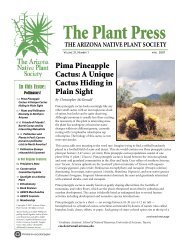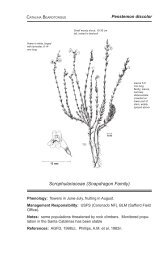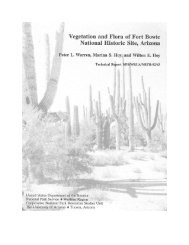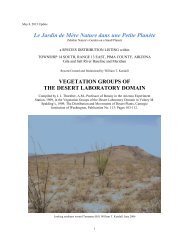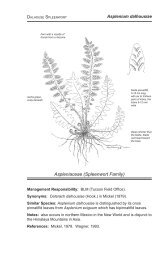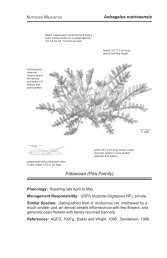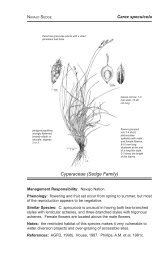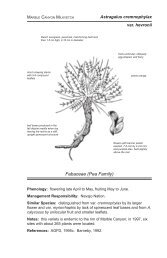T14S.R13E Pima County.AZ 050813 - Arizona Native Plant Society
T14S.R13E Pima County.AZ 050813 - Arizona Native Plant Society
T14S.R13E Pima County.AZ 050813 - Arizona Native Plant Society
You also want an ePaper? Increase the reach of your titles
YUMPU automatically turns print PDFs into web optimized ePapers that Google loves.
sandy loam, gravelly loam, gravelly-clayey loam, sandy loam, sandy-clayey loam, clayey loam, silty loam and loam ground;rocky clay, shaley clay, gravelly clay, sandy clay and clay ground; rocky silty, gravelly-silty, gravelly-sandy silty, sandy silty andsilty ground; humusy ground; chalky ground, and rocky powdery and powdery ground, occurring from sea level to 11,400 feet inelevation in the tundra, forest, woodland, scrub, grassland, desertscrub and wetland ecological formations. NOTES: This plantmay be an attractive component of a restored native habitat. This plant was reported to have been utilized by native peoples ofNorth America and could be investigated to determine its value as a home garden or commercial food crop. Bromus carinatus isnative to west-central and southern North America and Central America. *5, 6, 15, 30, 33 (Page 45), 43 (100209), 44 (032711),46 (Page 77), 56, 57, 58, 63 (100209 - color presentation), 77 (recorded as Bromus carinatus H.&A. [incl. B. arizonicus (Shear)Stebbins]. <strong>Arizona</strong> Brome), 80 (The Ergot Fungus (Claviceps sp.) is listed as a Secondary Poisonous Range <strong>Plant</strong>. Species of thegenus Bromus can be hosts of the Ergot Fungus. “Ergot contains poisonous alkaloids and other compounds that may causechronic poisoning (gangrenous ergotism) in the extremities when consumed in small amounts, or convulsive poisoning whenlarge amounts are eaten. Animals may be poisoned by feeding on mature, infected grain or hay. Livestock, especially cattle, andhumans are susceptible. ... Pastures causing ergot poisoning should be mowed or the animals removed. Mildly poisoned animalswill usually recover if removed from the infested pastures, kept quiet, and supplied with good feed and water. In <strong>Arizona</strong>, somelosses may be expected on rangelands during wet years, but most losses have occurred from grazing pastures of Dallas Grass(Paspalum dilatatum).” See text for additional information.), 85 (102511 - color presentation), 101 (color photograph), 124(032711), 127, 140 (Pages 201 & 299)*Bromus carinatus var. arizonicus (see Bromus arizonicus)Bromus carinatus var. carinatus (see footnote 85 under Bromus carinatus)Bromus catharticus M.H. Vahl: RescuegrassSYNONYMY: Bromus unioloides K.S. Kunth; Bromus willdenowii K.S. Kunth. COMMON NAMES: AustralianOats; Brome Grass (New Mexico, a name also applied to other species and to the genus Bromus); Bromo Cebadiila (Spanish);Cebadiila (Spanish); Flat Spiked Brome Grass; Flat-spiked Brome Grass; Horn Grass; Johnson Grass (a name also applied toother species); Rescue Brome; Rescue Brome Grass; Rescue Bromegrass; Rescue Grass (a name also applied to other species);Rescue-grass; Rescuegras; Rescuegrass; Schrader’s Brome (a name also applied to other species); Schrader’s Brome Grass;Schrader’s Bromegrass; Schrader’s Bromus; Schrader’s Grass; Schrader’s-grass; Southern Chess; Wild Brome Grass.DESCRIPTION: Terrestrial annual or perennial tufted graminoid (ascending and/or erect culms 10 inches to 4 feet in height); thefoliage is light green or green; the florets are green; flowering generally takes place between mid-March and mid-August(additional records: one for early January (in the Southern Hemisphere), two for mid-February, one for late February, one forearly September, one for mid-September, two for early October, one for mid-October and one for late November). HABITAT:Within the range of this species it has been reported from mountains; mesas; plateaus; rock walls; canyon rims; rocky canyons;gravelly and sandy canyon bottoms; talus slopes; meadows; foothills; rocky hills; bases of hills; sandy-loamy, sandy-clayey,loamy and silty slopes; bajadas; sand hills; sandy-loamy prairies; sandy flats; sandy-loamy basins; valley floors; clayey valleybottoms; coastal dunes; railroad right-of-ways; along sandy roadsides; draws; along bottoms of draws; seeps; springs; alongstreams; streambeds; along rivers; riverbeds; along and in cobbly washes; sandy drainages; drainage ways; in rocks aroundponds; freshwater marshes; along (loamy) banks of rivers and lakes; edges of springs, streams; rivers and marshes; along marginsof springs, rivers, washes and ciénegas; shores of rivers and lakes; sandy beaches; sandy benches; bottomlands; sandyfloodplains; mesquite bosques; along fencerows; margins of stock tanks; canals; along canal banks; ditches; along ditch banks;riparian areas; waste places, and disturbed areas growing in wet, moist and dry rocky, rocky-sandy, cobbly, gravelly and sandyground; gravelly loam, sandy loam and loam ground; sandy clay and clay ground; silty ground, and chalky ground, occurringfrom sea level to 12,600 feet in elevation in the forest, woodland, scrub, grassland, desertscrub and wetland ecologicalformations. NOTES: EXOTIC Invasive <strong>Plant</strong>. This plant was reported to have been utilized by native peoples of North America;it was noted as having been used as fodder. Bromus catharticus is native to South America. *5, 6, 15, 16 (recorded as Bromuswilldenowii Kunth), 33 (Page 44), 43 (100309), 44 (032711), 46 (Page 77), 56, 57, 58, 63 (100309 - color presentation), 68, 77,80 (The Ergot Fungus (Claviceps sp.) is listed as a Secondary Poisonous Range <strong>Plant</strong>. Species of the genus Bromus can be hostsof the Ergot Fungus. “Ergot contains poisonous alkaloids and other compounds that may cause chronic poisoning (gangrenousergotism) in the extremities when consumed in small amounts, or convulsive poisoning when large amounts are eaten. Animalsmay be poisoned by feeding on mature, infected grain or hay. Livestock, especially cattle, and humans are susceptible. ...Pastures causing ergot poisoning should be mowed or the animals removed. Mildly poisoned animals will usually recover ifremoved from the infested pastures, kept quiet, and supplied with good feed and water. In <strong>Arizona</strong>, some losses may be expectedon rangelands during wet years, but most losses have occurred from grazing pastures of Dallas Grass (Paspalum dilatatum).” Seetext for additional information. Rescuegrass, Bromus willdenowii (confused with Bromus catharticus) is also listed as a RarelyPoisonous and Suspected Poisonous Range <strong>Plant</strong>. “This introduced annual grass has been reported to develop toxicconcentrations of nitrate.”), 85 (102511 - color presentation), 89 (reported under Miscellaneous Introduced Species as being awinter annual herb, recorded as Bromus unioloides H.B.K.), 101 (color photograph), 124 (032711), 127, 140 (Page 299)*Bromus catharticus var. catharticus (see footnote 85 under Bromus catharticus)Bromus diandrus A.W. Roth subsp. rigidus (A.W. Roth) J.M. Lainz Ribalaygua: Ripgut Brome40



